We convened in the Patria Palace hotel in Lecce on Wednesday evening, the majority having arrived at Bari airport at midday and all of us exploring the beautiful baroque town of Lecce with its cream coloured stone carved into exquisite (and other) figures.
En route to our dinner, we called in at a wine bar where we meeted and greeted and enjoyed a Chardonnay/Verdeca/Fiano sparkling wine that was so light and refreshing it was hard to believe it came from this far south!
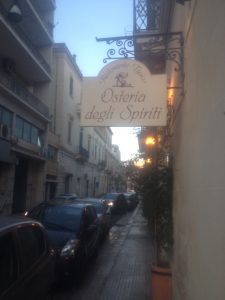 As with the previous tours our first night dinner was at Osteria degli Spiriti, a great introduction to the gastronomy of Puglia with dishes bursting with local ingredients – aubergines, courgettes, tomatoes, shrimp, sea bass and a sublime lemon cake to finish. A crisp Verdeca and a smooth Primitivo introduced those of us who had just arrived to some serious Puglia grape varieties, while others who had already been holidaying in the area told their stories of beautiful Masserias they had stayed in and their adventures in towns and trulli.
As with the previous tours our first night dinner was at Osteria degli Spiriti, a great introduction to the gastronomy of Puglia with dishes bursting with local ingredients – aubergines, courgettes, tomatoes, shrimp, sea bass and a sublime lemon cake to finish. A crisp Verdeca and a smooth Primitivo introduced those of us who had just arrived to some serious Puglia grape varieties, while others who had already been holidaying in the area told their stories of beautiful Masserias they had stayed in and their adventures in towns and trulli.
Thursday morning saw us on the bus by 9am, and Tim gave us an introduction to the Puglia wine scene en route to Manduria. Despite efforts to reduce its production, Puglia produces more wine than Australia, and wine is still shipped north to bolster weaker vintages. However, the days of subsidised wine lakes are over, and many producers are getting out of wine production or seeking to reposition. International varieties have been planted but more interestingly for us local varieties have been rediscovered, and modern wine making techniques applied to reveal their best qualities. Over our tour we would discover Nero de Troia, Bombino Nero and of course explore Primitivo (which some enterprising Puglia wine makers have labelled as Zinfandel and exported to the United States!).
Tim gave us a detailed exposition on Italian/Puglian wine classification culminating in the promise that we would taste Puglia’s current only DOCG (Primitivo Dolce de Manduria) on Saturday. No-one was prepared to admit who had asked the question leading to this, or indeed could remember what the question was!
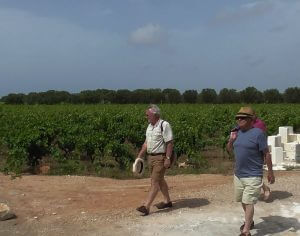 However, it filled the journey time nicely and we arrived at Morella at 10am.
However, it filled the journey time nicely and we arrived at Morella at 10am.
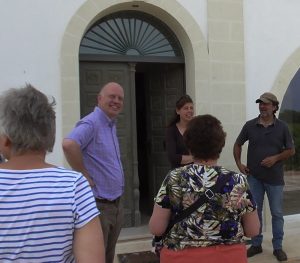 Lisa Gilbee, our host, is from Melbourne, Australia and studied at the famous Roseworthy College. She decided to do her ‘practical’ experience in Chianti Classico on the basis of Italian wines’ ‘Vegemite’ character, and following graduation and some years flying wine making, met Gaetano Morella in Manduria and decided both to marry him, and to dedicate her talents to producing fabulous quality wines from 12 hectares of old bush vines.
Lisa Gilbee, our host, is from Melbourne, Australia and studied at the famous Roseworthy College. She decided to do her ‘practical’ experience in Chianti Classico on the basis of Italian wines’ ‘Vegemite’ character, and following graduation and some years flying wine making, met Gaetano Morella in Manduria and decided both to marry him, and to dedicate her talents to producing fabulous quality wines from 12 hectares of old bush vines.
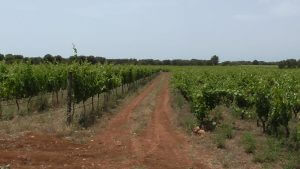
In addition to the old bush vines producing Primitivo, Lisa and Gaetano have planted Verdeca and Negroamaro on vertical trellises, and it was fascinating to hear Lisa talk about the benefits and disadvantages of this modern approach – far easier to manage in the vineyard but may not get the benefits bush vines have of receiving every hour of sunshine. We learnt that despite being so far south, these vineyards are cooler than those of northern Italy, thanks to the almost permanent winds. Today it was the Scirocco, bringing humid air up from the south, on other days the Maestro brings dry air from the north.
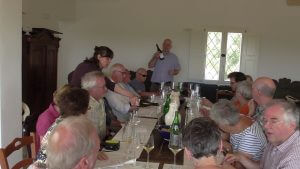 Keen to get out of the wind we went into their brand newly built home amid the vineyards for a tasting of six wines – two Fianos, demonstrating the ageing potential of this lovely grape; two blends of young vine Negroamaro and Primitivo, again the older one showing fascinating farmyard character; and two single vineyard Primitivos, which demonstrated brilliantly the point Lisa was making about how much variation there is even between neighbouring plots of land, due to decades of individual land owners replanting their preferred vines (nowadays called clonal selection).
Keen to get out of the wind we went into their brand newly built home amid the vineyards for a tasting of six wines – two Fianos, demonstrating the ageing potential of this lovely grape; two blends of young vine Negroamaro and Primitivo, again the older one showing fascinating farmyard character; and two single vineyard Primitivos, which demonstrated brilliantly the point Lisa was making about how much variation there is even between neighbouring plots of land, due to decades of individual land owners replanting their preferred vines (nowadays called clonal selection).
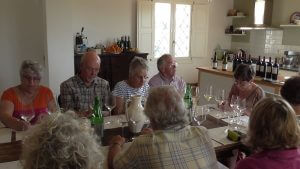 We pressed Lisa on how long all these wines would age, and it was fascinating to understand that while fine Primitivos are considered to be ‘worthy’ of ageing, other wines are just not laid down – her white wines and the Negroamaros are made to sell out the year they are produced, and we were only able to compare vintages thanks to a few cases she keeps back. And if you are running your business from your home (as we know), you don’t have the luxury of space to store too much wine.
We pressed Lisa on how long all these wines would age, and it was fascinating to understand that while fine Primitivos are considered to be ‘worthy’ of ageing, other wines are just not laid down – her white wines and the Negroamaros are made to sell out the year they are produced, and we were only able to compare vintages thanks to a few cases she keeps back. And if you are running your business from your home (as we know), you don’t have the luxury of space to store too much wine.
Lisa’s wines are available from Berry Brothers in the UK, and we agreed they were wines that we would want to revisit when we went home.
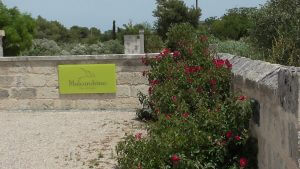 We tore ourselves away from a lively discussion about biodynamic wine production, which Lisa described be
We tore ourselves away from a lively discussion about biodynamic wine production, which Lisa described be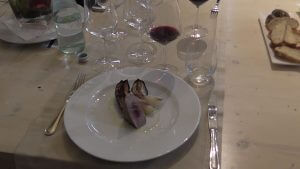 autifully as a philosophy of prevention rather than cure, to retrace our steps and have lunch at the Malcandrino restaurant – a place we wouldn’t have found ‘en passant’, as it is built in an old stone quarry. The meal was amazing – burrata on cured meats, octopus with beetroot, pasta, perfectly pink tuna and to finish a sublime ice-cream. In my madder moments I might try to replicate it at home! Lovely wines too – a white and a red from Salento and a Negroamaro rosé.
autifully as a philosophy of prevention rather than cure, to retrace our steps and have lunch at the Malcandrino restaurant – a place we wouldn’t have found ‘en passant’, as it is built in an old stone quarry. The meal was amazing – burrata on cured meats, octopus with beetroot, pasta, perfectly pink tuna and to finish a sublime ice-cream. In my madder moments I might try to replicate it at home! Lovely wines too – a white and a red from Salento and a Negroamaro rosé.
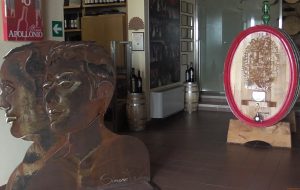 We rebooted ourselves for our final visit of the day to Apollonio. Far bigger scale than Morella, but with a massive dedication to art and reverence for the past. We were taken through the old cement tanks which were now storage for bottles and an underground tasting room, we viewed the bottling line with its barrel light
We rebooted ourselves for our final visit of the day to Apollonio. Far bigger scale than Morella, but with a massive dedication to art and reverence for the past. We were taken through the old cement tanks which were now storage for bottles and an underground tasting room, we viewed the bottling line with its barrel light 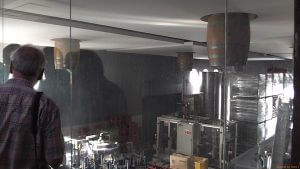 fittings, and we finally enjoyed a tasting of six wines that explored an amazing range of Puglia wines:
fittings, and we finally enjoyed a tasting of six wines that explored an amazing range of Puglia wines: